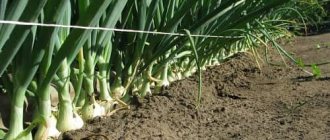Is it possible to plant radishes before winter?
The only drawback to planting radishes before winter is the risk of seed death if the grower chooses the wrong time for sowing. However, this rarely happens, so let’s pay attention to the advantages of the method:
- Unlike spring sowing, winter sowing brings the harvest several weeks earlier. If you cover the crops with polyethylene in the spring, the ripening time will be reduced by a few more days.
- Seeds sown in autumn are much stronger and stronger than spring seedlings, as they are hardened in the ground and become resistant to many aggressive factors. Weak seeds die, and strong ones develop faster.
- Pre-winter sowing provides the seeds with the necessary moisture after the snow melts. Seeds also undergo a process of natural stratification. Spring crops may suffer from a lack of moisture due to the soil being overdried by the active sun.
- When sown in winter, radishes become resistant to diseases and pests and are not afraid of frost.
Having tried growing radishes in this way once, the vegetable grower will return to this method again, since this method has a lot of advantages.
Is it worth the risk?
This issue must be resolved by each gardener personally. But it is worth paying attention to several clear advantages of sowing vegetables in winter. Let's voice them:
- it will allow you to get a harvest 2-3 weeks earlier than in spring, and if you cover the seedlings with film (or other covering material), you can speed up ripening by another 7-12 days. The result is almost a month!;
- seeds that spent the whole winter in the ground were well hardened, went through natural selection (the weak ones died), which means the plants will be stronger and healthier;
- with winter sowing, you can forget about worries about a dry spring: as soon as the snow begins to melt, the seeds swell and begin to grow together, using 100% of the spring moisture, at a time when spring sowing is still being planned.
The seeds have hardened well over the winter, which means the plants will be stronger and healthier
- resistance to frost, diseases and pests: young sprouts of winter-sown vegetables and herbs can withstand short-term negative temperatures without loss (from personal experience I can say that a temperature of -3°C will not cause them the slightest harm), and early shoots are not attacked by carrot flies and cruciferous flea beetles, which are still sleeping at this time.
What varieties of radish are best to plant before winter?
The ideal radish variety for winter sowing has the following characteristics:
- not afraid of lack of light;
- frost-resistant;
- not prone to shooting.
Experienced gardeners prefer varieties such as Zhara, Zarya, and Rose-red.
Heat and Dawn ripen early. Root crops are harvested 15-25 days after germination. In addition, Zarya is distinguished by its high yield and resistance to light deficiency. The fruits have a pleasant taste, slightly spicy.
Pink-red radishes ripen at an average speed: vegetables begin to be harvested approximately 25-30 days after germination. This variety has a balanced taste, which is why it is very popular.
Planting radishes in the fall, before winter, is a risky business, but if you follow all the rules, then in early spring you can delight yourself with fresh vegetables.
Planting dates in different regions
When should you plant radishes? The most important thing in sowing before winter is that the seeds should hatch, but not sprout.
- If the ground freezes, it will be very difficult to dig up the soil and the seeds will not be able to germinate.
- If planted in early autumn, radishes may sprout and die during the first night frost.
Therefore, it is very important to observe the weather and study the climate of your region.
- In the southern regions of Russia, radishes are planted much later than in the northern regions.
- In the central region, sowing begins in the second ten days of October, it was at this time that the ground was already frozen to 3 cm.
- Experts recommend sowing seeds in the northern regions in early October, since in these latitudes the first frosts begin in the second half of September.
- In the southern regions, it is necessary to sow radishes in late October or early November, since warm weather lasts for a very long time in this region.
Landing dates were only approximate because the weather is unpredictable.
How to properly plant radishes before winter
Before the onset of frost, the bed reserved for sowing is slightly loosened and fluffed up. The site is chosen on a slight elevation so that when the snow melts, the seeds do not flood.
Soil preparation
Autumn radishes grow well in garden beds where cucumbers, tomatoes, garlic, potatoes, peas and beans were previously cultivated. Undesirable predecessors: Cabbage, daikon, radish, horseradish and watercress are all members of cruciferous vegetables, as they accumulate common diseases and enemies that are transmitted through the soil.
The soil is prepared immediately after harvesting the previous crop. The soil is dug up, at the same time removing weeds and plant debris. Under digging for 1 sq. m add 25-35 g of superphosphate and ammonium nitrate, and also add 35 g of potassium sulfate - preferably in dissolved form.
On a note . If the soil on the site is severely depleted, then compost or humus is added to it (a bucket per 1 sq. m).
After digging and applying fertilizer, the soil is well loosened to a depth of 18-22 cm, this depends on the chosen litter.
Seed selection and preparation
First, the seeds are calibrated: placed in a saline solution for several minutes. The seeds that float up are thrown away, and those that sank to the bottom are taken out and dried. Next, the seeds are disinfected for about 20-30 minutes in a slightly pink solution of potassium permanganate, washed and dried again. Such preparation will allow you to grow large fruits and protect the crop from diseases. It is important that the seeds only swell, but do not germinate, otherwise they will die.
On a note. For autumn planting, prepare twice as many seeds as for spring sowing, since the planting material may be of poor quality, the seeds will not hatch and will die.
Planting pattern and depth
Grooves are made at a distance of 20 cm from each other . Then dry seeds are embedded in them to a depth of no more than 5-6 cm. Leave 3-5 cm between the seeds. The crops are sprinkled with dry soil.
The bed is covered with a layer of mulch, which will act as a protective cushion for the seeds. Mulching will protect the seedlings from temperature changes, spring thaws and frosts. Spruce branches or branches of shrubs are used as mulch. The bed is covered with a 20 cm layer. In winter, the beds are insulated with snow - this will help the seeds to successfully overwinter.
Important ! The place where radishes are sown should never be moistened, otherwise the seeds will hatch and die from frost.
When to sow and how to do it correctly
Perhaps the sowing time is the most important issue. But no one will tell you the exact date; you will have to choose it yourself. Here you need to catch the moment when stable cold is about to set in: a thaw after winter sowing is extremely undesirable, since the seeds can germinate and die with the arrival of frost.
You can start sowing already at 0°C, but if there is a possibility of the temperature rising, it is better to wait. The main criterion is the freezing top layer of soil. Even if yesterday it was +5°C, and today it’s immediately -5°C, you can safely sow.
It is also important to arrange the garden bed correctly. It needs a higher place, where with the arrival of spring the soil dries out faster and warms up well. Areas where snow does not melt for a long time in the spring and water stagnates are not suitable for winter crops.
Please note: the bed for winter crops is prepared in advance. The soil is dug up and fertilizers are applied. It’s up to you to decide which ones; gardeners have different opinions here. Some prefer to apply compost or humus, others prefer phosphorus-potassium fertilizers. The main thing is that the soil for winter sowing is fertile and light - heavy soils become very compacted during the winter.
Preparing the bed
Make grooves 3-5 cm deep in the garden bed, cover it with covering material so that precipitation does not wash out the grooves and weed seeds do not get into them. Dry soil and mulching material are prepared in advance. Completely dry seeds are sown in furrows (for winter sowings, seed consumption is increased by 1.5-2 times!), sprinkled with 1.5-2 cm of dry soil on top, then a 2-3 cm layer of mulching material. In spring, mulch will prevent the appearance of crusts on the soil surface and protect the root system from sudden temperature changes. Then the bed is covered with spruce branches or dry leaf litter (place small branches on top to prevent it from being blown away by the wind). The thickness of this shelter is 15-20 cm. There is no need to water winter crops!
Features of caring for such a planting
When warm weather arrives, the shelter is removed and the first shoots wait for the appearance. First of all, plants are provided with a comfortable “population density”. To do this, remove the weakest shoots so that the distance between the root crops is at least 5 cm.
Watering
Water depending on rainfall. Due to a lack of moisture, fruits become tough and will taste bitter, and due to its excess, vegetables become watery and tasteless. If there is no rain, water, but moderately. To prevent the formation of a crust on the top layer of soil from watering, the soil must be loosened.
For your information . Radishes are grown both in separate beds and in mixed plantings next to cucumbers, potatoes and cabbage.
Top dressing
If the soil is depleted, a herbal infusion diluted with water is used as a fertilizer. To prepare the fertilizer, fill the container a quarter full with water, then add recently collected herbs at the rate of 1 kg of plants per 10 liters of water and add 2 kg of dry chicken manure. The container is covered with a net.
The infusion is stirred every day and used only after the mixture stops fermenting, that is, when bubbles stop appearing. This takes 1-3 weeks. The resulting infusion is mixed with water in a 1:1 ratio. The product is watered at the roots of the plants.
On a note. If the soil is fertile, it is not necessary to apply fertilizers.
Diseases and pests
With the onset of warm weather, winter radishes are at risk from whiteweed, cruciferous flea beetles, clubroot, bacteriosis and blackleg.
An effective and safe way to control insects is to use ash and tobacco dust. If there are few pests, it is enough to lightly dust the tops with ash. Ash particles enter the respiratory tract of pests, causing their death.
In the future, to protect the plants, the radishes are sprinkled with lime and ash in a 1:1 ratio once a week. The procedure is carried out in dry weather and must be repeated after rains. A decoction of onion peels, which is used to water the seedlings, also helps well. The pungent odor repels insects.
In case of massive damage to plants, the following drugs are used:
- "Arrivo";
- "Kaiser";
- "Zolon";
- "Alfacin";
- "Tod."
Bordeaux mixture or lime solution is used against bacteriosis and clubroot: 100 g of lime is stirred in 2 liters of water. Blackleg is treated with a solution of 50 g of laundry soap and 1 tbsp. l. copper sulfate diluted in 10 liters of water.
Harvesting and recommendations
Before harvesting vegetables, the garden bed must be watered. Before morning harvesting, the soil is moistened in the evening, before daytime harvesting - 2-3 hours.
Recommendations for proper collection and storage of root vegetables:
- When harvesting, radishes are simply pulled by the tops.
- Before pulling the radish out of the ground, the soil from the top of the plant is lightly raked to determine the size of the root crop. All vegetables with a diameter of 2.5 cm or more are removed. If the root crop of the selected plant is still small, it is sprinkled with earth, allowing it to ripen.
- Since winter radishes ripen quickly, vegetables are checked as often as possible so as not to miss the right moment of collection.
- For further storage, vegetables are shaken off the ground, but not washed, the tops are cut off, leaving 3 cm. The fruits are placed in a plastic bag and sent to the refrigerator. This way, root crops will retain their marketability and taste for a long time.
Pre-winter sowing - early vitamins from the garden
By spring, we had already used up the supply of vitamins accumulated over the spring, summer and autumn, when there was an abundance of fresh berries, vegetables and fruits. Fruits and vegetables stored for winter, no matter what ideal conditions are created for them, lose a significant part of their nutrients by spring. How can we make up for the resulting deficit?
You can buy gifts of nature in a supermarket or market. Of course, if you trust the integrity of the manufacturers. Or purchase a complex of vitamins in tablets at the pharmacy (and don’t forget about quality here). But there is another way: to sow vegetables and herbs in your garden before winter.
In early spring, the lack of vitamins is especially acute.
Leaf and head lettuces, arugula, dill, parsley, spinach, spring onions, radishes, beets and carrots - how do you like the star composition for a spring vitamin salad? Do you remember that young leaves and petioles of carrots and beets are a storehouse of vitamins? They are also in the salad! Before winter, you can also sow cauliflower, Chinese and red cabbage, salad mustard, celery (for greens), borage and parsnips.
Fighting cruciferous flea beetles
Nobody recommends using chemicals to control cruciferous flea beetles. We take the most terrible allergen, having previously put on protective gloves and a respirator - mustard and carefully, a very tiny pinch, sprinkle the rows of radishes. You can also use hot ground pepper, and you need a maximum of a teaspoon of mustard and pepper per square meter. After this, the crops need to be covered with a non-woven covering material, creating something like a greenhouse with a chemical attack on flea beetles.
An original way to protect radishes from cruciferous flea beetle:
About seven days before sowing radishes in the ground, it is necessary to sow watercress and mustard, and after another seven days, sow radishes in the rows of these crops. We act like Sherlock Holmes: the flea attacks the seedlings of competitors, we treat them with approved insecticides, strictly following the instructions on the packaging, and kill them, after which we just have to wait for the radishes to sprout and cut off the plants we don’t need that serve as bait. This method may well help, you can try it.
Cabbage fly
They say the cabbage fly is a terrible coward, and if you plant celery next to the garden bed (usually on its periphery), then it certainly will not come close to the areas of your radish.
Kila
As we already mentioned, acidic soils can be dangerous for radishes due to clubroot damage. If you are able to determine the pH of the soil or know that it is definitely acidic, then before sowing we recommend adding 150-200 g of chalk, 250-300 g of lime or 250-350 g of dolomite flour to the soil, of course, calculated per square meter and , ideally, for a year, but it is possible at least a month before sowing the radishes. Wood ash is a good soil deoxidizer; among other things, it contains up to 5% potassium and a fairly large composition of microelements, although in small quantities. Wood ash can be sprinkled in a millimeter layer directly into the base of the hole, and radish seeds can be sown on top.
Overgrown radish
The best radish varieties for winter sowing
The main thing is that the radish variety is resistant to bolting, frost-resistant and not afraid of the lack of light. Experienced gardeners suggest choosing varieties such as “Zhara”, “Zarya” or pink-red with a white tip for planting in winter.
The first two varieties grow very early, within 15-25 days. “Zarya” is also distinguished by its enormous yield, with a very mild taste, but a little spicy. It is also very important that this variety is not afraid of the lack of light, so it is ideal for winter planting.
Rose-red radishes are a mid-early variety and begin to ripen approximately 25 or 30 days after emergence. But, the main thing is that this variety has a very pleasant taste and is extremely popular among gardeners.
Planting radishes in winter is a very risky activity, but if you follow all the rules, then in early spring you can already please yourself with fresh radishes, which are rich in vitamins and bring exceptional health to the body.
Recommendations from gardeners
Experienced gardeners advise growing radishes for sale, as they grow relatively quickly. And if you apply a sowing frequency of 10 days, use different varieties and growing methods, then you can have a constant income all year round.
Experience has shown that, if possible, it is better to avoid sowing radishes in months with long daylight and hot days. A lot of expenses go into growing, and the result is not always pleasing. It's better to skip June and July.
Tricks for planting radishes in a greenhouse from Yulia Minyaeva
Working with autumn radishes in spring
As soon as the spring warmth stabilizes, the first shoots will begin to appear, which will be much stronger than those that will be planted in the spring. It is believed that they are not afraid of light frosts, but to get the earliest possible harvest, you should cover the beds with film, then success will be one hundred percent, and you will be one of the first to enjoy tasty, beautiful and early radish root crops.
Planting autumn radishes is a proven practice that only needs a first experiment, because those who have used this technique at least once and appreciated all its advantages do this planting every year.
Read: Growing radishes at home. Choosing varieties
Join our Facebook group
Varieties of vegetables for winter sowing
Considering that when sowing before winter, the seeds are in harsh conditions, they must have good germination, be large, and full-bodied. Therefore, it is better to buy high-quality varietal seeds than to use your own - this is not the case when the savings are justified. You can purchase pelleted seeds: additional protection will reduce the risk of their death.
For winter sowings, choose vegetable seeds especially carefully.
Choose varieties that, when exposed to low temperatures, do not form peduncles or form only a very low percentage of the total number.











